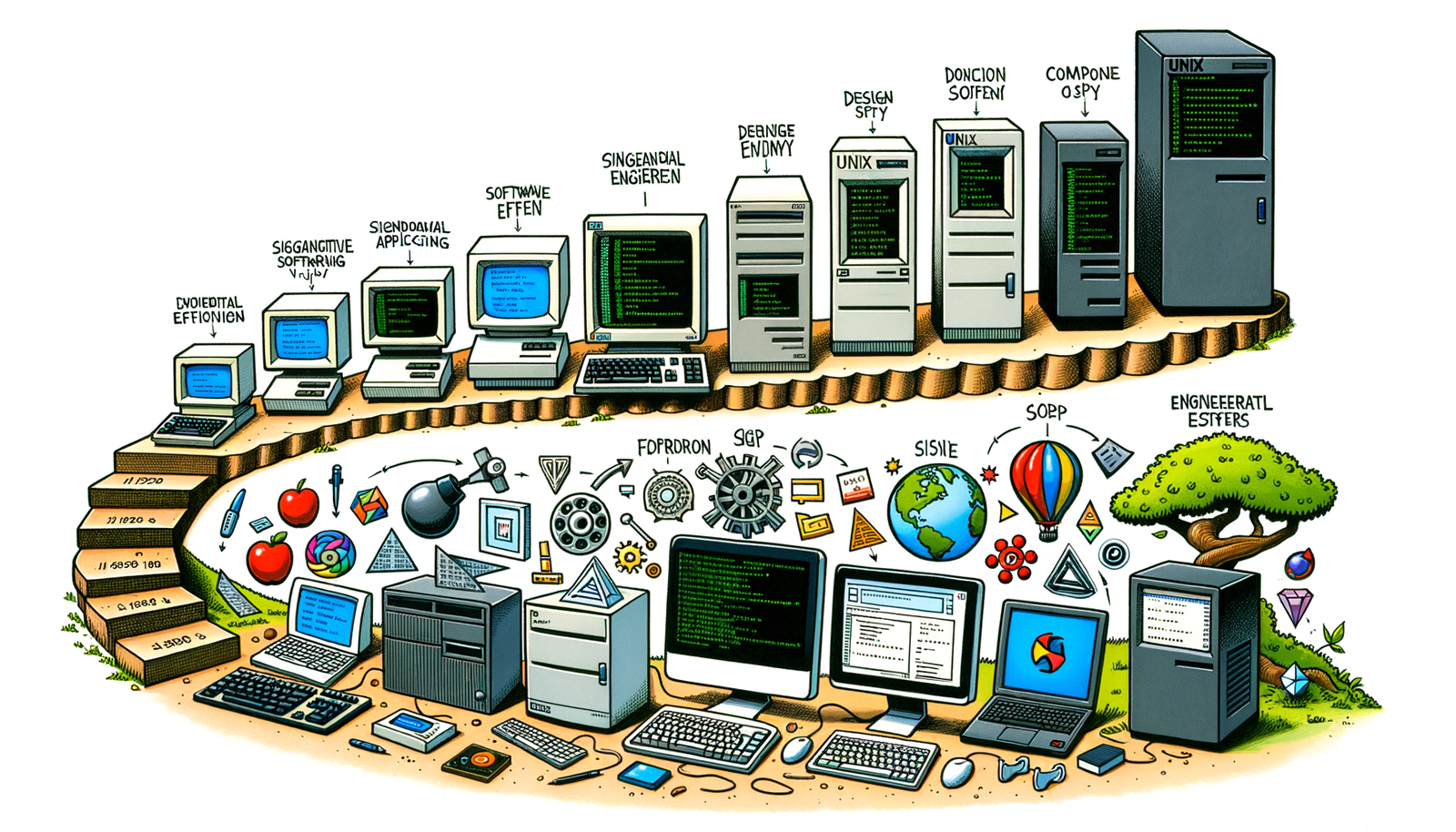Your Cart is Empty
Customer Testimonials
-
"Great customer service. The folks at Novedge were super helpful in navigating a somewhat complicated order including software upgrades and serial numbers in various stages of inactivity. They were friendly and helpful throughout the process.."
Ruben Ruckmark
"Quick & very helpful. We have been using Novedge for years and are very happy with their quick service when we need to make a purchase and excellent support resolving any issues."
Will Woodson
"Scott is the best. He reminds me about subscriptions dates, guides me in the correct direction for updates. He always responds promptly to me. He is literally the reason I continue to work with Novedge and will do so in the future."
Edward Mchugh
"Calvin Lok is “the man”. After my purchase of Sketchup 2021, he called me and provided step-by-step instructions to ease me through difficulties I was having with the setup of my new software."
Mike Borzage
Design Software History: The Evolution of UNIX and Its Pivotal Role in Shaping Design Software Development and Engineering Applications
April 13, 2025 4 min read


Introduction to UNIX in Design Software Development
The advent of UNIX as a powerful, multi-tasking, and multi-user operating system marked a pivotal moment in the history of computing and, by extension, the development of design software. Originating in the late 1960s at Bell Laboratories, UNIX was the brainchild of visionary computer scientists Ken Thompson, Dennis Ritchie, and their colleagues. Their goal was to create a portable, flexible, and efficient operating system that could serve as a robust platform for a variety of computing needs. This innovative system introduced concepts that were revolutionary at the time, such as hierarchical file systems, inter-process communication, and a modular kernel, which collectively contributed to its adaptability and widespread adoption. The multi-user capabilities and strong security features of UNIX made it an ideal environment for collaborative work, which is essential in design and engineering fields. Furthermore, its portability allowed it to be used across different hardware platforms, making it a versatile choice for developers. In the realm of computer-aided design (CAD), UNIX provided a stable and efficient platform that could handle the complex computations and graphical requirements of early design software. Its influence set the stage for significant advancements in CAD systems, facilitating innovations that would shape the future of design and engineering industries.Key Design Software Developed on UNIX
The integration of UNIX into academic institutions played a crucial role in the early development of design software. Universities embraced UNIX for its openness and flexibility, which provided a fertile ground for experimentation and innovation in software development. This environment nurtured the creation of several significant design systems that would become industry staples. One notable example is AutoCAD by Autodesk, which, during its evolution, utilized UNIX-based workstations to enhance its capabilities. Founded by John Walker in 1982, Autodesk recognized the potential of UNIX systems to support complex graphical applications, leading to the development of more sophisticated versions of AutoCAD that could handle intricate design tasks. Similarly, Dassault Systèmes, a French company established in 1981, harnessed the power of UNIX to develop CATIA (Computer Aided Three-Dimensional Interactive Application). This software became a cornerstone in aerospace, automotive, and industrial equipment design due to its advanced modeling capabilities supported by UNIX's robust performance. Additionally, Parametric Technology Corporation (PTC), founded by Samuel P. Geisberg in 1985, developed Pro/ENGINEER, one of the first parametric, feature-based solid modeling CAD software. UNIX systems provided the necessary computational power and multitasking capabilities to handle Pro/ENGINEER's complex algorithms and graphical processing. Collaborations with companies like Silicon Graphics, Inc. (SGI) further enhanced the graphical capabilities of design software on UNIX platforms. SGI's advanced graphics workstations, running on UNIX, enabled the development of highly detailed and interactive design applications, pushing the boundaries of what was technologically possible at the time.UNIX's Impact on Design Software Development Processes
UNIX profoundly influenced the development processes of design software through its emphasis on open standards and the use of the C programming language. The UNIX philosophy advocated for software that was modular, portable, and efficient. By leveraging C, developers could write code that was easily portable across different hardware systems, significantly reducing development time and costs. This portability was essential for design software companies aiming to reach a broader market. Moreover, UNIX's inherent support for networking facilitated collaborative work environments. Designers and engineers could access shared resources and work remotely, which was a significant advancement for team-based projects requiring constant communication and collaboration. UNIX's multi-tasking capabilities allowed for complex computations and rendering processes to run simultaneously without overloading the system. This efficient resource management was critical for CAD applications that demanded high computational power and graphical processing. The ability to handle multiple processes enabled software like CATIA and Pro/ENGINEER to perform real-time modeling and simulations, which were essential for iterative design processes. Additionally, UNIX's security features ensured that sensitive design data was protected, instilling confidence in companies to adopt UNIX-based systems for their critical operations.The Decline and Enduring Legacy of UNIX in Design Software
Despite its early dominance, UNIX faced a decline with the rise of more accessible operating systems like Microsoft Windows. The introduction of Windows NT in the 1990s offered a user-friendly interface and broader compatibility with existing PC hardware, making it an attractive option for businesses and individual users. This shift led design software companies to develop versions of their applications compatible with Windows to cater to the expanding market. However, UNIX's concepts and technologies continued to influence the industry. Derivatives like Linux, which embraced UNIX principles, gained popularity for their open-source nature and flexibility. Linux found a niche in large-scale engineering projects and server environments where stability and customization were paramount. Many design software companies began to offer support for Linux, recognizing its value in certain sectors. Moreover, the minimalist and efficient design ethos of UNIX persisted in modern systems. The principles of modularity, portability, and efficient resource management pioneered by UNIX are evident in current operating systems and software development practices. Design software continues to benefit from these concepts, ensuring that applications are scalable, maintainable, and capable of meeting the increasing demands of complex design tasks.Conclusion
UNIX's contribution to the evolution of design software is undeniably significant. As a versatile and stable platform, it enabled the development of some of the earliest and most influential CAD systems. Companies like Autodesk, Dassault Systèmes, and PTC leveraged UNIX's strengths to create powerful design tools that revolutionized engineering and manufacturing processes. The operating system's emphasis on portability, multi-user capabilities, and efficient resource management provided a solid foundation for innovation. UNIX's tradition of excellence and reliability continues to inspire advancements in design software. The principles established by UNIX have become integral to software development, emphasizing the importance of open standards and collaborative environments. Looking to the future, UNIX-based and UNIX-inspired systems are poised to play a role in specialized fields that require robust and secure platforms. As industries move towards more complex and computationally intensive design processes, the foundational elements of UNIX may offer solutions that address these emerging challenges. The legacy of UNIX in design software serves as a testament to the enduring impact of visionary technologies and the people who create them.Also in Design News

Rhino 3D Tip: AOV-Based Render Pass Workflow for Rapid, Non‑Destructive Compositing
December 28, 2025 2 min read
Read More
Cinema 4D Tip: Consolidate Geometry with Connect Objects + Delete
December 28, 2025 2 min read
Read More
V-Ray Tip: Region Rendering Best Practices for Fast, Seamless Comp Patches
December 28, 2025 2 min read
Read MoreSubscribe
Sign up to get the latest on sales, new releases and more …


